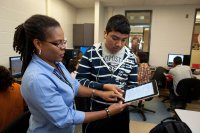Distance Learning Strategies to Bring Back to the Classroom
When schools closed, teachers were forced to get creative—and they’ve learned things they can use when they’re back at school.
Your content has been saved!
Go to My Saved Content.Before my eighth-grade history students moved into online learning this spring, I had no idea about one student’s affection for Cup Noodles or another’s sweet way of talking about her 5-year-old brother. Perhaps I should have known, but I didn’t, and I wish I had.
Distance learning has enabled these intimate glimpses into students’ lives and thought processes, and I worry that these moments won’t happen as much once we eventually return to campus. However, I realize that doesn’t have to be the case—and so I’ve been thinking a lot lately about ways to translate the best aspects of online instruction to the physical classroom.
What I Want to Bring Back to My Classroom
Providing feedback on what works in a quick email: With all of us being so far from each other and everything being turned in online, it feels natural to send a handful of kids two-line emails for each small assignment, highlighting something specific that worked. I’m judicious about doing this so that I don’t spend forever grading quick-completion assignments. However, I do want students to know that I’m seeing their work and thinking about them.
I’d love to continue this practice back in the physical classroom, even if it’s only for a minute during class while students are working on something else, because it can be more permanent and private than saying something aloud.
Following along online while talking with students about their projects: While discussing research that students have done for history projects, it’s been easy to look at and comment on the group’s shared Google Doc while they’re in a Zoom breakout group with me. Back in the physical classroom, I’d like to carry my laptop around more often so that I’m not simply looking over their shoulders, but also engaging with them by making written comments in real time that they can follow up on later.
Screen sharing has been invaluable for helping students investigate whether a source is valid or find citation information. It’s also helped me navigate tech questions, such as how to move a file into a Google Drive folder. Even in a regular classroom, I could take more time to walk individual groups through processes like these.
Using exit tickets as a formative assessment: I’ve used online exit tickets for different purposes, whether asking students to summarize their progress on a group project or to write about what made a podcast powerful. I hadn’t consistently used exit tickets in the physical classroom, but now I want to. The information they provide has shaped my understanding of my students and helped me plan for the next class.
When we’re back in the classroom, I’d like to think about how best to do an exit ticket according to the daily lesson. Some days it might be a Google Form so that I can compile, copy, and save information easily. Other days it might be a projected chat window where students can talk about what they found interesting about a topic. Other times, it might be an old-fashioned slip of paper so that I can keep feedback anonymous and sort ideas into categories.
Offering creative and fun summative assessments: Since we transitioned to distance learning, my students have appreciated that their teachers have assigned creative projects, both to individualize instruction and to give students a chance to socialize through virtual breakout groups. My students also like offering feedback on their classmates’ projects through Google Drive and Google Forms. These compliments are much easier to pass along than the handwritten comments that students used to write in class.
Providing space for relevant side chatter: Even with a focus on content-driven responses, there’s still room for appropriate humor and on-the-side interaction among students. I’ve been delighted by the informality of kids’ chipping in an idea that they don’t necessarily want to interrupt class to share but that they do want to get out there. (As I’m teaching, I monitor the chat, laugh along with the students, and then suggest that they lay off if it goes too long!) It would be ideal to keep this chat going every day in the physical classroom, maybe on a screen behind me, so that I can hear from every kid more frequently throughout class.
Introducing warm-up questions about students’ lives: My favorite part of online learning has been the immediate glimpse of students’ lives that they offer in the chat at the beginning of our eighth-grade U.S. history Zoom sessions each day. I post a question, students respond, and I call on a few to explain.
Lighter questions have included: What did you have for breakfast or lunch today? What is something you’ve enjoyed creating or doing with your hands this week?
Heavier questions have included: What is something nice you could do (or have done) for someone else while in quarantine? What have you learned about yourself or others while at home?
For the last question, I have loved hearing from some seemingly extroverted students who found that they were enjoying time alone, and vice versa. Some kids have discovered that they like cooking, and others their siblings’ sense of humor. I have also heard from a few kids whose answers concerned me, and I followed up later with them or their counselor.
In a recent survey, a number of students said that they also love this daily warm-up, that it makes “the feel of this class familiar and comfortable.” I plan to incorporate this quick check-in either by voice or onscreen, or both, when we’re back together in real life—which I hope will be sooner rather than later.
